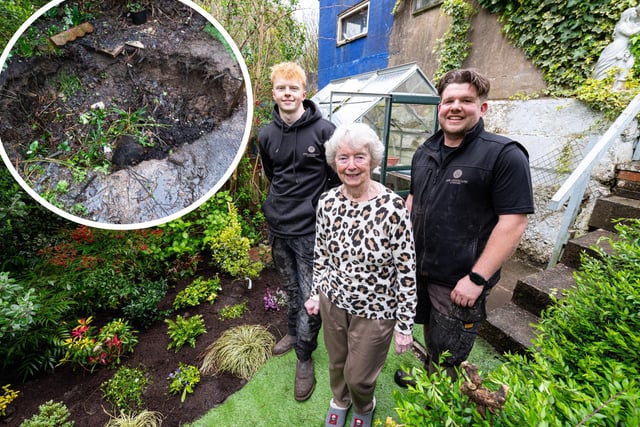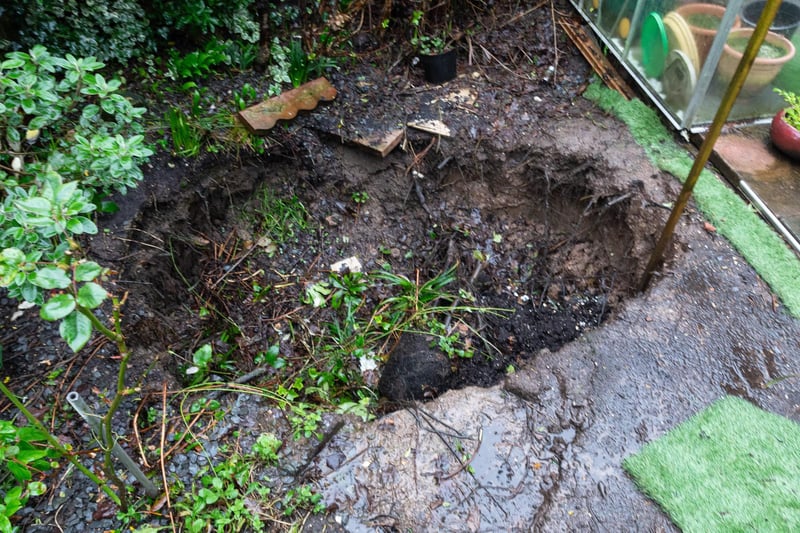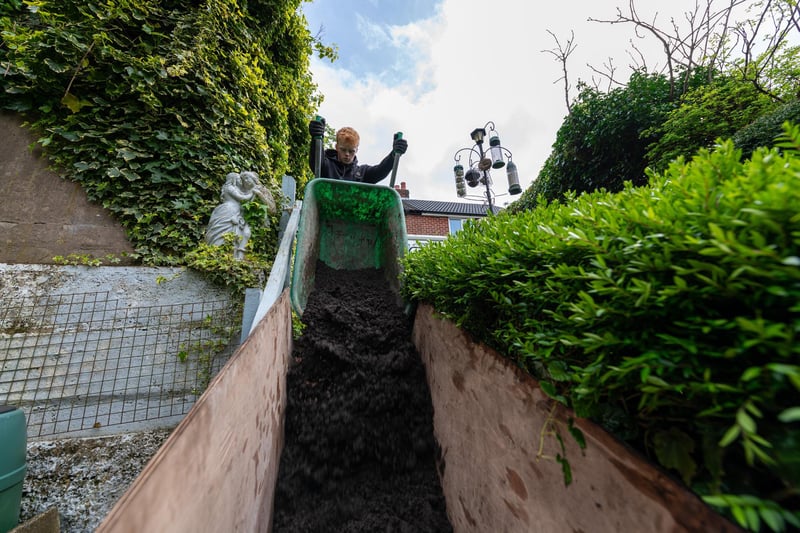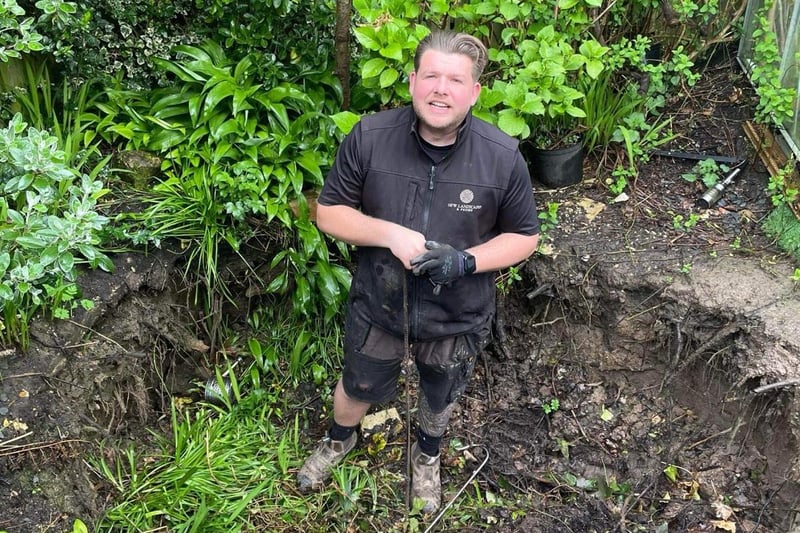As the Lancashire Post revealed in February, Dororthy Rigby felt she had been left with nowhere to turn after being told by her home insurer and the local council that they could neither rectify nor explain the crater.
Its sudden appearance last August – and continued growth until the turn of the year – saw the 83-year-old banished from much of her beloved green space for fear that she would go the same way as many of her plants, which simply vanished into the void .
Now, however, a local landscaping firm has stepped in to put the garden back on firm foundations – free of charge – and restore Dorothy’s delight in her miniature oasis, along with her peace of mind.
Armed with materials supplied by C&W Berry Builders’ Merchants in Leyland and plants from Bannister Hall Nurseries in Higher Walton, Nick Whittle from Chorley-based NFW Landscapes and Paving set about removing all traces of the unwanted talking point which had terrorised Dorothy for months.
She told the Post that the worry and sense of despair she had experienced had led her to consider leaving her home of almost 25 years.
“I thought of selling up, because I just felt so helpless. I’ve always sorted out my own problems, but I just couldn’t get any answers.
“The night after it had been done, I slept through for the first time in months. People can’t always understand why something like this gets to you, but my garden is my life – and I’d really given up on it.
“So I just can’t thank [everybody involved] enough – I thank them from the bottom of my heart,” Dorothy said.
She was less enthused, however, about the response to her plight from officialdom. While she was grateful for a visit from a member of South Ribble Borough Council’s environmental health team and an inspection of her drains, the authority said it was ultimately unable to help because the sinkhole had sprung up on private land.
Dorothy was particularly disappointed that an engineer’s report prepared by her home insurer, LV, was not shared with her, leaving her in the dark about the cause of the four foot wide, three foot deep hole – and unsure how to tackle it once she was advised that it was her responsibility to have it put right.
“They wouldn’t tell me anything,” she recalls. “So I just hope it doesn’t happen again, because we never found out what caused it in the first place.”
LV and South Ribble Borough Council have been approached for comment.
The firms that swung into action to help – none of whom sought any publicity for their efforts – have handed Dorothy a garden she can once again enjoy and feel safe in.
For Nick Whittle, 33, the reason that he and 19-year-old colleague Rob Smith gave up an entire day to carry out the work can be summed up in a simple sentiment: “If it were my nan, I’d want someone to help”, he told the Post.
“I just felt sorry for her – you could tell how much it meant to her and I’m really glad she’s made up [with the result].”
Nick said the most difficult part of the job was gaining access to the garden, which meant all of the infill material had to be wheeled through in individual barrows.
While he was reassured by the engineer’s assessment that the hole had now reached clay, he was tentative about first stepping into it – and, it turns out, with good reason.
“Before I got in, I wanted to make sure it was safe, so I tested it by putting fencing pins into [the base] – and it was still soft.
“I was losing a four-foot fencing pin each time [I pressed it down], so it was obviously really wet clay.”
Meanwhile, Jon Hollywood, from Bannister Hall Nurseries, said his company was just happy to be able to replace the blackness of the sinkhole with a colourful collection of new plants for Dorothy to enjoy.
“If there’s something that needs doing in the community, we just do it – people just need to give us a call,” Jon said.
For Dorothy, her new garden has made her feel like she is “born again”.
“I want to get cracking on [tending] the part of the garden I haven’t been able to get to since last year [because of the sinkhole]. Now I just can’t wait for summer,” she smiled.
‘IT RESTORES YOUR FAITH IN HUMANITY’
Help for Dorothy came when one of her friends shared the Post article highlighting her situation on social media – and made a direct appeal to local firms to help.
“”There’s so much doom and gloom around, but this is a really positive story,” Debbie Noblett said.
“Nick Whittle and Rob Smith did some real graft and gave up a full day’s pay – it restores your faith in human nature.
“They also clearly both had a lot of respect for her, even though they’d never even met.”
As well as being grateful for their hard work, Dorothy herself was similarly uplifted by what she believes it signifies.
“It just shows there are some good people about”, she added.
WHAT CAUSED DOROTHY’S SINKHOLE?
With a question mark still hanging over the cause of the sinkhole that has blighted Dorthy’s back garden for the best part of a year, the Post asked the British Geological Survey (BGS) if any of its experts could shed any light on the subject.
Vanessa Banks – a Karst hydrogeologist and engineering geologist at the BGS – said that the “weight of limited evidence” from local data points to one particular option, which is likely to have been exacerbated by recent wet weather conditions.
“The geology beneath [Dorothy’s road] comprises the Singleton Mudstone Formation overlain by glacial till [rock material transported by a glacier and deposited].
“The glacial till is likely in the order of 5-10 metres thick – although there is limited borehole evidence to support this estimation – and this should protect the Singleton Mudstone Formation from water ingress.
“The glacial till may contain pockets of uncemented sediments that are prone to suffosion – physical grain-by-grain removal rather than dissolution – in the context of a through-flow of water.
“To the south of [the road], our records indicate that there is a spring that feeds – or once supplied – a well. This suggests that there is some flow of water towards the Hennel Brook in the subsurface, which may support [the glacial till theory], but also indicates the possibility of there having been a well in the garden of the house in question.
“[However], having looked at historic maps of the area, I have not found any evidence to support this hypothesis,” Vanessa explained.
While she stressed that it was not the role of BGS to advise on mitigation measures against sinkhole , Vanessa said “water management is particularly important and avoidance of focused flow, as may occur on the edge of hardstanding [material], into the subsurface is advisable”.

1. Sinkhole sorted
Dorothy Rigby was delighted by the generosity of Nick Whittle (right) and Rob Smith, from NFW Landscapes and Paving in Chorley, who filled in the sinkhole (inset) that her dominated her back garden since late last summer Photo: Kelvin Stuttard


3. Sinkhole sorted
Access to the back garden proved a challenge, with all of the infill having to be wheelbarrowed down a specially-creared chute constructed around a set of steps Photo: Kelvin Lister-Stuttard

4. Sinkhole sorted
Nick Whittle had to make sure he was on solid ground before he got to work on - and in - the sinkhole Photo: Debbie Noblett